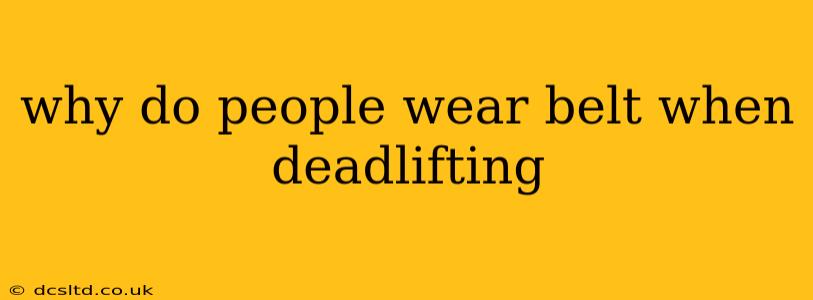Deadlifting is a powerful exercise that demands significant core stability and spinal support. Many lifters choose to wear a weightlifting belt during deadlifts, and for good reason. This practice isn't just about looking the part; it offers tangible benefits in terms of performance and injury prevention. This guide delves into the reasons behind belt usage, addressing common questions and misconceptions.
What are the benefits of wearing a weightlifting belt when deadlifting?
The primary advantage of wearing a weightlifting belt during deadlifts is the increased intra-abdominal pressure (IAP). This pressure acts like a natural corset, stabilizing your spine and protecting it from excessive shear forces during heavy lifts. Think of it as creating a more rigid structure around your core, providing crucial support where you need it most. This increased stability allows you to lift heavier weights safely and efficiently.
Does wearing a belt improve deadlift performance?
While a belt doesn't directly add strength, it allows you to utilize your existing strength more effectively. By enhancing spinal stability, it reduces the risk of injury and allows you to focus on the lift itself, rather than bracing against potential spinal instability. This improved stability can translate to better form, increased confidence, and potentially heavier lifts. However, it's crucial to understand that a belt is a tool, not a magical solution. Proper technique and training remain paramount.
When should I use a weightlifting belt when deadlifting?
The decision of whether or not to wear a belt during deadlifts depends on several factors, including your individual experience level and the weight being lifted. Generally, it's recommended to use a belt for heavier sets (near your 1-5 rep max) where spinal stability is most crucial. For lighter warm-up sets or higher-repetition sets, a belt may not be necessary. Learning to brace your core effectively without a belt is also beneficial.
Is it bad to deadlift without a belt?
Deadlifting without a belt is not inherently bad, particularly for lighter weights or higher repetitions. Many experienced lifters choose to deadlift without a belt regularly. However, it’s crucial to develop a strong core and proper bracing technique to protect the spine. Ignoring proper form and bracing can lead to injury regardless of whether you're wearing a belt.
How tight should a weightlifting belt be?
The tightness of your weightlifting belt is crucial. It should be snug enough to provide support without restricting breathing. You should be able to take a deep breath comfortably while wearing the belt. Too loose, and it offers minimal support; too tight, and it can restrict your breathing and potentially lead to discomfort. Experiment to find the optimal level of tightness for your body.
What are the disadvantages of wearing a weightlifting belt when deadlifting?
While benefits abound, there are some potential drawbacks to consider. Over-reliance on a belt can hinder core muscle development. If you constantly rely on the belt for support, your core muscles might not develop the strength and stability needed to perform deadlifts safely without it. This can lead to a dependence on the belt, making it difficult to deadlift without it. Furthermore, improperly fitting or using a belt can lead to discomfort or even injury.
Should beginners wear a weightlifting belt when deadlifting?
For beginners, focusing on mastering proper form and developing core strength is crucial. While a belt might seem like a safety net, prioritizing technique and building a strong core is more effective in the long run. A belt can be introduced later as strength and proficiency improve.
Conclusion:
A weightlifting belt can be a valuable tool for enhancing performance and preventing injuries during deadlifts, particularly for heavier sets. However, it’s not a replacement for proper form, core strength, or a well-structured training program. Beginners should prioritize technique and core development before relying heavily on a belt. Learning to brace properly without a belt is also essential for long-term strength gains and injury prevention. Always listen to your body, and adjust your belt usage accordingly.
